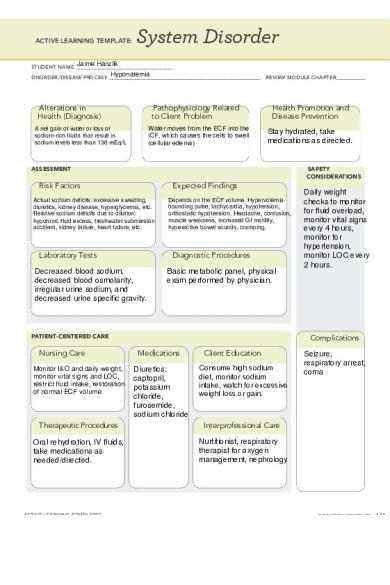ATI System Disorder Hyponatremia PDF

| Title | ATI System Disorder Hyponatremia |
|---|---|
| Course | Pharmacology for Professional Nursing |
| Institution | Rasmussen University |
| Pages | 1 |
| File Size | 87.8 KB |
| File Type | |
| Total Downloads | 95 |
| Total Views | 165 |
Summary
ATI System Disorder Template Worksheet on Hyponatremia...
Description
ACTIVE LEARNING TEMPLATE:
System Disorder
Jaime Hanzlik ST UDENT NAME _____________________________________ Hyponatemia DISORDER/DISEASE PROCESS __________________________________________________________
Alterations in Health (Diagnosis)
Pathophysiology Related to Client Problem Water moves from the ECF into the ICF, which causes the cells to swell (cellular edema)
A net gain of water or loss of sodium-rich fluids that result in sodium levels less than 136 mEq/L
REVIEW MODULE CHAPTER ___________
Health Promotion and Disease Prevention Stay hydrated, take medications as directed.
ASSESSMENT
SAFETY CONSIDERATIONS
Risk Factors
Expected Findings
Actual sodium deficits: excessive sweating, diuretics, kidney disease, hyperglycemia, etc. Relative sodium deficits due to dilution: hypotonic fluid excess, freshwater submersion accident, kidney failure, heart failure, etc.
Laboratory Tests
Depends on the ECF volume. Hypervolemiabounding pulse, tachycardia, hypotension, orthostatic hypotension. Headache, confusion, muscle weakness, increased GI motility, hyperactive bowel sounds, cramping.
Diagnostic Procedures
Decreased blood sodium, decreased blood osmolarity, irregular urine sodium, and decreased urine specific gravity.
Basic metabolic panel, physical exam performed by physician.
PATIENT-CENTERED CARE
Nursing Care Monitor I&O and daily weight, monitor vital signs and LOC, restrict fluid intake, restoration of normal ECF volume
Complications Medications Diuretics: captopril, potassium chloride, furosemide, sodium chloride
Client Education Consume high sodium diet, monitor sodium intake, watch for excessive weight loss or gain.
Therapeutic Procedures
Interprofessional Care
Oral rehydration, IV fluids, take medications as needed/directed.
Nurtitionist, respiratory therapist for oxygen management, nephrology
ACTIVE LEARNING TEMPLATES
Daily weight checks to monitor for fluid overload, monitor vital signs every 4 hours, monitor for hypertension, monitor LOC every 2 hours.
Seizure, respiratory arrest, coma
THERAPEUTIC PROCEDURE
A11...
Similar Free PDFs

ATI System Disorder Hyponatremia
- 1 Pages

System disorder hyponatremia
- 1 Pages

ATI System Disorder Bipolar
- 1 Pages

ATI System Disorder Hyperkalemia
- 1 Pages

ATI System Disorder Dehydration
- 1 Pages

ATI System Disorder - CHF
- 1 Pages

ATI System Disorder Hypoglycemia
- 1 Pages

VaricELL ATI SYSTEM DISORDER TEM
- 1 Pages
Popular Institutions
- Tinajero National High School - Annex
- Politeknik Caltex Riau
- Yokohama City University
- SGT University
- University of Al-Qadisiyah
- Divine Word College of Vigan
- Techniek College Rotterdam
- Universidade de Santiago
- Universiti Teknologi MARA Cawangan Johor Kampus Pasir Gudang
- Poltekkes Kemenkes Yogyakarta
- Baguio City National High School
- Colegio san marcos
- preparatoria uno
- Centro de Bachillerato Tecnológico Industrial y de Servicios No. 107
- Dalian Maritime University
- Quang Trung Secondary School
- Colegio Tecnológico en Informática
- Corporación Regional de Educación Superior
- Grupo CEDVA
- Dar Al Uloom University
- Centro de Estudios Preuniversitarios de la Universidad Nacional de Ingeniería
- 上智大学
- Aakash International School, Nuna Majara
- San Felipe Neri Catholic School
- Kang Chiao International School - New Taipei City
- Misamis Occidental National High School
- Institución Educativa Escuela Normal Juan Ladrilleros
- Kolehiyo ng Pantukan
- Batanes State College
- Instituto Continental
- Sekolah Menengah Kejuruan Kesehatan Kaltara (Tarakan)
- Colegio de La Inmaculada Concepcion - Cebu







